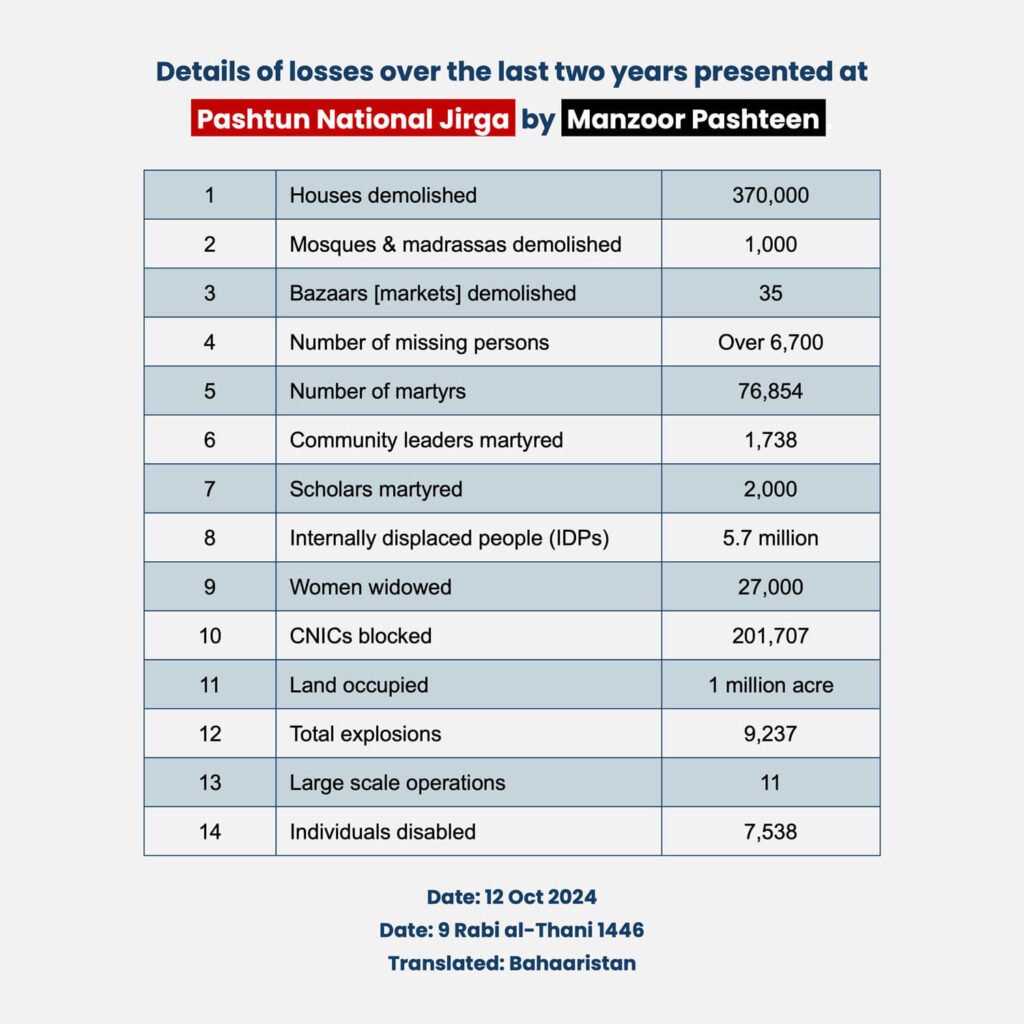Pakistan
Pashtun National Jirga Report reveals deep wounds of conflict over the last 20 years
The Pashtun National Jirga revealed alarming stats that highlight the impact of militancy & subsequent anti-terrorism operations, which have killed thousands & displaced millions across KP over the last two decades.

The Pashtun Jirga, locally known as Pushtoon Qaumi Jirga, was organized in Jamrud by the Pashtun Tahaffuz Movement (PTM) with the support of the provincial government. It formally began on Saturday, October 12, 2024, with high hopes of finding solutions to issues of peace, security, and justice in a region ravaged by conflict and militancy for years.
The jirga concluded on Sunday, October 13, 2024, with delegates deploring the impact of militancy and subsequent anti-terrorism operations that have killed thousands and displaced millions of Pashtun people over the last two decades.
Delegates from various political parties and professional organizations, including Pashtun leaders, engaged in discussions across 60 separate enclosures to present their recommendations for the final declaration at a larger forum.
During the Pashtun National Jirga, a two-hour documentary was screened, highlighting the devastating effects of violence and displacement in Khyber Pakhtunkhwa.
According to the data collected by PTM and presented at the jirga, military operations over the past two decades have displaced 5.7 million people, with at least 2.3 million still homeless. This displacement, along with the destruction of their homes, has forced many to live in desperate conditions.
Additionally, 76,584 individuals from Khyber Pakhtunkhwa, including 1,375 tribal leaders and 3,000 religious figures, have been killed in bomb blasts and targeted attacks over the last 20 years. At least 6,700 people went ‘missing’ and remain missing. These are gross human rights violations that are particularly devastating for the families.


The Jirga findings also reveal that 213 female members of polio vaccination teams have been tragically killed while carrying out life-saving campaigns. This harsh reality highlights the dangers faced by health workers striving to eliminate polio in a violence-stricken region, such as the Pashtun Belt.
The report further details the bitter Shia-Sunni conflict in Kurram Agency, which has claimed 4,100 lives, deepening religious divides.
In addition to the loss of human lives, the destruction of infrastructure is also staggering: over 370,000 homes and mosques have been reduced to rubble, with South Waziristan particularly hard hit, as 150,000 of these were located there. Moreover, 9,237 major explosions have hit Pashtun lands, while over 300 landmine blasts have resulted in the death or disability of over 1,000 people and animals.
The Pashtun identity has also been targeted, with over 200,000 ID cards blocked, leaving citizens unable to access basic rights and services. Such cases of human rights abuses and denying them basic citizen rights have bred a sense of deprivation among the Pashtun people.
Furthermore, Pashtun National Jirga also highlighted the economic toll, as 8.5 million barrels of oil have been exported from the Karak region in Khyber Pakhtunkhwa over the past 11 months, yet local people see little benefit from their natural resources.
This documentary, along with other videos featuring victims of the war, was broadcast live on 43 screens across 13 countries, ensuring that the global Pashtun diaspora remained connected to the Jirga.
